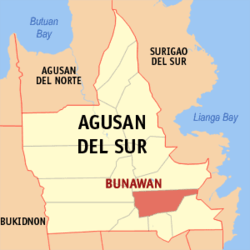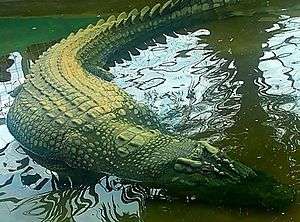Bunawan, Agusan del Sur
| Bunawan | ||
|---|---|---|
| Municipality | ||
| ||
 Location within Agusan del Sur province | ||
.svg.png) Bunawan Location within the Philippines | ||
| Coordinates: 8°11′N 125°59′E / 8.18°N 125.99°ECoordinates: 8°11′N 125°59′E / 8.18°N 125.99°E | ||
| Country | Philippines | |
| Region | Caraga (Region XIII) | |
| Province | Agusan del Sur | |
| District | 2nd district of Agusan del Sur | |
| Founded | January 26, 1959 | |
| Barangays | 10 (see Barangays) | |
| Government [1] | ||
| • Type | Sangguniang Bayan | |
| • Mayor | Edwin G. Elorde | |
| Area[2] | ||
| • Total | 512.16 km2 (197.75 sq mi) | |
| Population (2015 census)[3] | ||
| • Total | 45,151 | |
| • Density | 88/km2 (230/sq mi) | |
| • Voter (2016)[4] | 21,060 | |
| Time zone | PST (UTC+8) | |
| ZIP code | 8506 | |
| IDD : area code | +63 (0)85 | |
| Income class | 1st class | |
| PSGC | 160302000 | |
| Website |
www | |
Bunawan, officially the Municipality of Bunawan (Filipino: Bayan ng Bunawan), is a municipality in the province of Agusan del Sur in the Caraga (Region XIII) of the Philippines. The population was 45,151 at the 2015 census.[3] In the 2016 election, it had 21,060 registered voters.[4] Bunawan was created on June 21, 1959, through Republic Act No. 2517.[5] The world's largest crocodile, Lolong, was captured in the town on September 2011.[6]
Geography
Bunawan is located at 8°11′N 125°59′E / 8.18°N 125.99°E.
According to the Philippine Statistics Authority, the municipality has a land area of 512.16 square kilometres (197.75 sq mi)[2] constituting 5.13% of the 9,989.52-square-kilometre- (3,856.98 sq mi) total area of Agusan del Sur.
Barangays
Bunawan is politically subdivided into 10 barangays.[7]
| PSGC | Barangay | Population | ±% p.a. | ||
|---|---|---|---|---|---|
| 2015[3] | 2010[8] | ||||
| 160302001 | Bunawan Brook | 11.7% | 5,283 | 5,063 | +0.81% |
| 160302002 | Consuelo | 21.1% | 9,528 | 5,863 | +9.69% |
| 160302008 | Imelda | 3.7% | 1,672 | 1,179 | +6.88% |
| 160302003 | Libertad | 14.6% | 6,583 | 6,018 | +1.72% |
| 160302004 | Mambalili | 6.7% | 3,008 | 2,355 | +4.77% |
| 160302009 | Nueva Era | 3.0% | 1,375 | 1,139 | +3.65% |
| 160302005 | Poblacion | 11.9% | 5,379 | 4,683 | +2.67% |
| 160302006 | San Andres | 7.4% | 3,336 | 3,043 | +1.77% |
| 160302007 | San Marcos | 2.7% | 1,212 | 896 | +5.92% |
| 160302010 | San Teodoro | 17.2% | 7,775 | 7,243 | +1.36% |
| Total | 45,151 | 37,482 | +3.61% | ||
Demographics
| Population census of Bunawan | |||||||||||||||||||||||||
|---|---|---|---|---|---|---|---|---|---|---|---|---|---|---|---|---|---|---|---|---|---|---|---|---|---|
|
| ||||||||||||||||||||||||
| Source: PSA[3][8][9] | |||||||||||||||||||||||||
In the 2015 census, Bunawan had a population of 45,151.[3] The population density was 88 inhabitants per square kilometre (230/sq mi).
In the 2016 election, it had 21,060 registered voters.[4]
Schools
| Name | Barangay |
|---|---|
| East Bunawan Central Elementary School | San Teodoro |
| West Bunawan Central Elementary School | Poblacion |
There are three high schools in the municipality.
| School | Barangay |
|---|---|
| Agusan del Sur State College of Agriculture and Technology | San Teodoro |
| Bunawan National High School | San Teodoro |
| Libertad National High School | Libertad |
Bunawan has 1 college, the Agusan del Sur State College of Agriculture and Technology.
Crocodile Lolong

In early September 2011, local residents and veteran crocodile hunters caught a 6.17-metre-long (20.2 ft) saltwater crocodile weighing 1,075 kilograms (2,370 lb) in a local creek. The municipality planned to make the giant beast the centerpiece of an ecotourism park for species found in the marshlands.[6]
On November 9, 2011, the National Geographic Team confirmed that Lolong was the world's biggest crocodile.[10] The crocodile was transferred at the Bunawan Eco-Park and Research Center in Barangay Consuelo.
Villagers had witnessed the crocodile attack and kill a water buffalo, and they suspected it also killed a fisherman who went missing that summer. Experts from an area crocodile farm were called in to capture the wild animal, which destroyed four traps before a stronger one caught it. A hundred villagers were needed to drag the crocodile to a truck before a crane was used to put it in a truck. From there it was taken to a special cage where it was expected to be held until the ecotourism park was built around it.[6]
The crocodile was declared dead a few hours after flipping over in a pond with a bloated stomach on February 10, 2013.[11] The crocodile, despite being responsible for many deadly attacks, will be mourned by residents of the town, as it was the only tourist attraction that kept the town from sulking in obscurity. Its remains will be preserved to allow the municipality to keep its fame.
Several other crocodiles roam the marshy areas on the outskirts of town, and villagers have been told to avoid the marshes at night.[6]
References
- ↑ "Municipality". Quezon City, Philippines: Department of the Interior and Local Government. Retrieved 31 May 2013.
- 1 2 "Province: Agusan del Sur". PSGC Interactive. Makati City, Philippines: Philippine Statistics Authority. Retrieved 28 October 2016.
- 1 2 3 4 5 "CARAGA". Census of Population (2015): Total Population by Province, City, Municipality and Barangay (Report). PSA. Retrieved 20 June 2016.
- 1 2 3 "2016 National and Local Elections Statistics". Commission on Elections. 2016.
- ↑ "Republic Act No. 2517 - An Act Creating the Municipality of Bunawan, Province of Agusan". Chan Robles Virtual Law Library. 21 June 1959. Retrieved 18 October 2016.
- 1 2 3 4 "Giant crocodile captured alive in Philippines". Yahoo! News. Manila, Philippines. Associated Press. 5 September 2011. Archived from the original on 8 September 2011. Retrieved 18 October 2016.
- ↑ "Municipal: Bunawan, Agusan del Sur". PSA. Philippines: National Statistical Coordination Board. Retrieved 8 January 2016.
- 1 2 "CARAGA". Census of Population and Housing (2010): Total Population by Province, City, Municipality and Barangay (Report). NSO. Retrieved 29 June 2016.
- ↑ "CARAGA". Census of Population (1995, 2000 and 2007): Total Population by Province, City and Municipality (Report). NSO. Archived from the original on 11 November 2011.
- ↑ "NatGeo team confirms Lolong the croc is world's biggest". GMA News Online. 10 November 2011. Archived from the original on 5 April 2012. Retrieved 18 October 2016.
- ↑ Shears, Richard (10 February 2013). "Villagers in tears as world's largest crocodile dies in Philippines (Just don't ask what killed him... )". The Daily Mail Online. Associated Newspapers Ltd. Archived from the original on 12 February 2013. Retrieved 18 October 2016.
External links
 |
Rosario |  | ||
| La Paz Loreto |
|
Bislig, Surigao del Sur | ||
| ||||
| | ||||
| Veruela | Santa Josefa / Trento |
